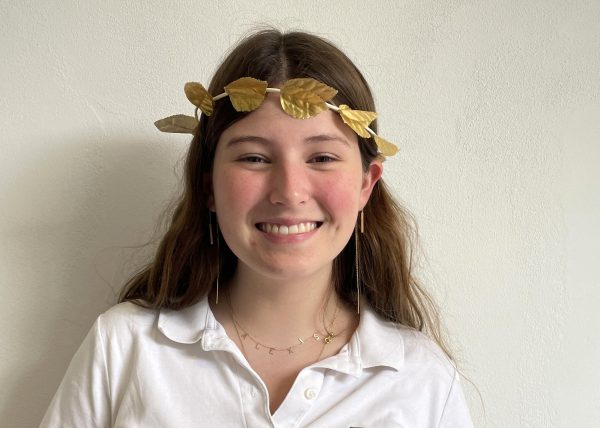Give and receive: Chinese students practice with Taiwanese tutors
Photo credit: Alexis David
Gosselin teaches Chinese 3 students about hobbies in their new unit, Unit 29. They will later use this knowledge to communicate with their tutors. “[The students] will be able to use what they have learned in class to talk with [their] Chinese tutor,” Gosselin said. “[The tutors] talk to the students, ask questions and answer questions [from] the students.”
December 7, 2021
Chinese classes at Archer have long used pen pal programs with students across the globe, sending letters back and forth to practice their writing skills. However, for the first time, Chinese students at Archer have the opportunity to meet with them. In the 2021-2022 school year, Chinese classes 2 and 3 introduced a new tutoring program involving college students across the world.
The program requires students to attend Zoom meetings with Taiwanese college students who are training to teach Chinese as a second language. The teachers, who are preparing to teach Chinese to English speakers, need the experience teaching Chinese in English, so these sessions allow both the students and teachers to practice their language skills.
Pei-Ying Gosselin, a Chinese teacher at Archer, explained how she came up with the program.
“Years ago, I participated in this teacher professional development program in Taiwan,” Gosselin said. “[It was] two weeks, and every day was from 8 a.m. to 5 p.m. I met this professor from Taitung University, and he told us that he has some students that are going to be Chinese teachers, but they didn’t really have opportunities to practice their teaching skills.”
Gosselin thought it would be beneficial to both her students and the teachers to work with each other so that her students could practice Chinese, and the teachers could practice their teaching skills. The tutoring sessions follow Archer’s curriculum, so, as the students are learning one unit, they are practicing the same unit with their tutors.
“I figured, to best benefit our students, [we should] insert this program in our Chinese curriculum,” Gosselin said. “The students are able to speak freely with the sentence structures we learned the entire unit.”
Sophomore Remi Cannon, a student in Chinese 3, talked about what a typical tutoring session looks like.
“Our Chinese tutors will send us, within the week we meet with them, a Google classroom link and a time to join,” Cannon said. “We open up with a short introduction and then we jump into something our Chinese class calls a speaking sheet.”
The speaking sheets used in the tutoring sessions are sheets of questions that require the usage of vocabulary words and sentence structures learned throughout the unit.
Despite the organization of the sessions, they are not without their challenges. Cannon discussed how the time differences and language barriers impact the sessions.
“We do create pretty detailed vocabulary lists to help us answer the questions [from the speaking sheets], but when we want to continue our conversation, the vocabulary gets a little limited because of the language barrier,” Cannon said.
Freshman Eden Sinclair, a student in Chinese 2, also commented on these challenging circumstances and how the language barrier led to self-doubt.
“We can only speak in Chinese,” Sinclair said. “So, sometimes when [my tutor] asks me questions, I don’t understand. I’m like ‘What do I say? How do I ask ‘What does this mean?’’’ without speaking English.”
Despite the challenging language barrier, the students and tutors were able to assist each other when they came across bumps in the road.
“We’re able to help each other,” Cannon said. “[We] lend each other the words that we need to communicate. Even though there are awkward pauses, we still persist.”
After the introduction of the program, Gosselin can already see improvement within her students.
“The students’ confidence level definitely improved,” Gosselin said. “In America, there are not a lot of opportunities for the students to practice with native speakers. The Chinese 3 students have to talk for at least 40 minutes in each meeting, so they definitely feel more confident and comfortable speaking to the Chinese tutors.”
Cannon also spoke on how important confidence is when speaking Chinese and discussed how the tutoring sessions helped boost her own.
“A lot of Chinese is about confidence,” Cannon said. “Because it is such a difficult language, it takes a lot of courage to just talk with your peers in class or answer questions out loud. Having to spend 30 minutes talking to someone with a big language barrier takes a lot of courage and confidence. Seeing that it wasn’t too bad, wasn’t too scary, makes me a bit more confident in participating in my Chinese class.”
Sinclair has also noticed improvement in her Chinese skills as she’s had more meetings with her tutor, indicating the success of the sessions.
“The first meeting I had with her was, in my mind, horrible,” Sinclair said. “There’d just be times where I had no idea what was happening and I was lost — I didn’t know how to communicate – but, by the next session, I was able to pick up a little bit more of what she was trying to ask and I also started asking more questions in Chinese.”
Beyond the tutoring, the students have been able to create real bonds with their tutors, some of the pair even following each other on social media platforms.
“My tutor is a sweetheart,” Cannon said. “I just felt really connected to her even through a screen, when I knew she was across the world.”




![Gosselin teaches Chinese 3 students about hobbies in their new unit, Unit 29. They will later use this knowledge to communicate with their tutors. "[The students] will be able to use what they have learned in class to talk with [their] Chinese tutor," Gosselin said. "[The tutors] talk to the students, ask questions and answer questions [from] the students."](https://archeroracle.org/wp-content/uploads/2021/12/chineseclassnotyellowtint-900x600.jpg)





